Part II: Financial project analysis of Austin Water’s GoPurple program

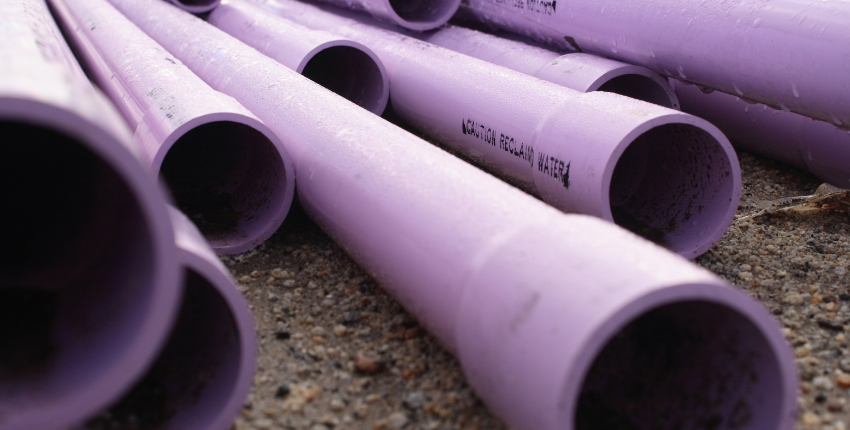
In our previous blog outlining Austin Water’s new GoPurple initiative we included a decision tree that aims to assist owners and engineers with breaking down what is required and what is optional for their project under the updated onsite reuse requirements. If you haven’t started with that post, we suggest you go check it out, and then come back here for financial analyses of a few example projects in Austin that fall under this new code!
Example Project #1
Endeavor Development at 8440 Burnet Road
This project is a new multifamily development that will be located at the current site of the Spectrum Shopping Mall in North Austin. The project has the following characteristics:
- 5 stories
- 500,000 square feet
- 367 apartments
- Estimated 740 occupants
Using the decision tree presented in our previous blog, we can see that the project has two options:
- Install an Onsite Reuse System; or
- Install dual plumbing and pay a fee in lieu.

So which option makes most sense for the project? Let’s break it down.
Option 1: install an onsite reuse system, has two sub-options. The first is to install a rainwater and condensate reuse system. The second is to install a greywater or blackwater reuse system. Both systems would qualify the project for capacity charge reductions, expedited building permit review, and PACE funding. However, only the greywater/blackwater system option qualifies the project for the Pilot Incentive program, which offers up to $500,000 of funding.
The required recycled water end uses under the updated code are toilet flushing, irrigation, and cooling towers. The 8440 Burnet project is assumed to have minimal irrigation and no cooling towers, so the primary end use for the onsite treatment system will be toilet flushing. Through the water balance calculations, we come up with the following results:
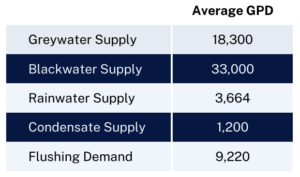
These results indicate that the estimated rainwater and condensate will not be able to supply the full non-potable demand throughout the year, and makeup municipal water would be needed to supplement the system. Greywater and blackwater, however, would each be able to adequately meet 100% of the non-potable demand. The project can pursue an Above & Beyond Grant by choosing a greywater or blackwater system in this case, as the supply exceeds the minimum code-required supply (rainwater and condensate). The excess water savings that a greywater or blackwater system could provide would be:

Since the Above & Beyond water savings exceed 1,000,000 gallons, the project would qualify for the $500,000 grant by installing a greywater or blackwater system. Now that we have system sizes, we can compare the preliminary costing models.

The Year 1 costs include estimated system costs, tankage and installation, including estimated piping costs for recycled water piping and greywater waste piping. The Year 1 incentives are applicable only to greywater and blackwater projects as part of the Pilot Incentive Program, whereas the annual incentives apply to all three types of systems in the form of capacity fee reductions. The Annual Savings are in the form of water and sewer utility savings. In addition to the incentives, including an onsite reuse system has the advantage of only having to pay connection fees for potable water, rather than both potable and recycled connections.
From these values we estimate the first costs for all three systems would be similar, but the rainwater system has the lowest first cost and the lowest operating cost. However, the rainwater and condensate system is not able to fully meet the non-potable demand, therefore incurring additional water and sewer utility fees.
How does this compare to Option 2?
Option 2 would be for the project to install dual plumbing to required end uses, make the required infrastructure designs to ready itself for future connection to reclaimed water, and pay a fee in lieu upfront. The fee is equal to 500 feet of linear pipe, estimated at $160,640 upfront cost for an 8” branch connection, an estimated pipe size needed to serve the full non-potable demand.

So now we have preliminary costs for all the options that would comply with the Onsite Reuse code. Which is the best value for the project? The graph below shows all four options’ cumulative costs over 15 years.
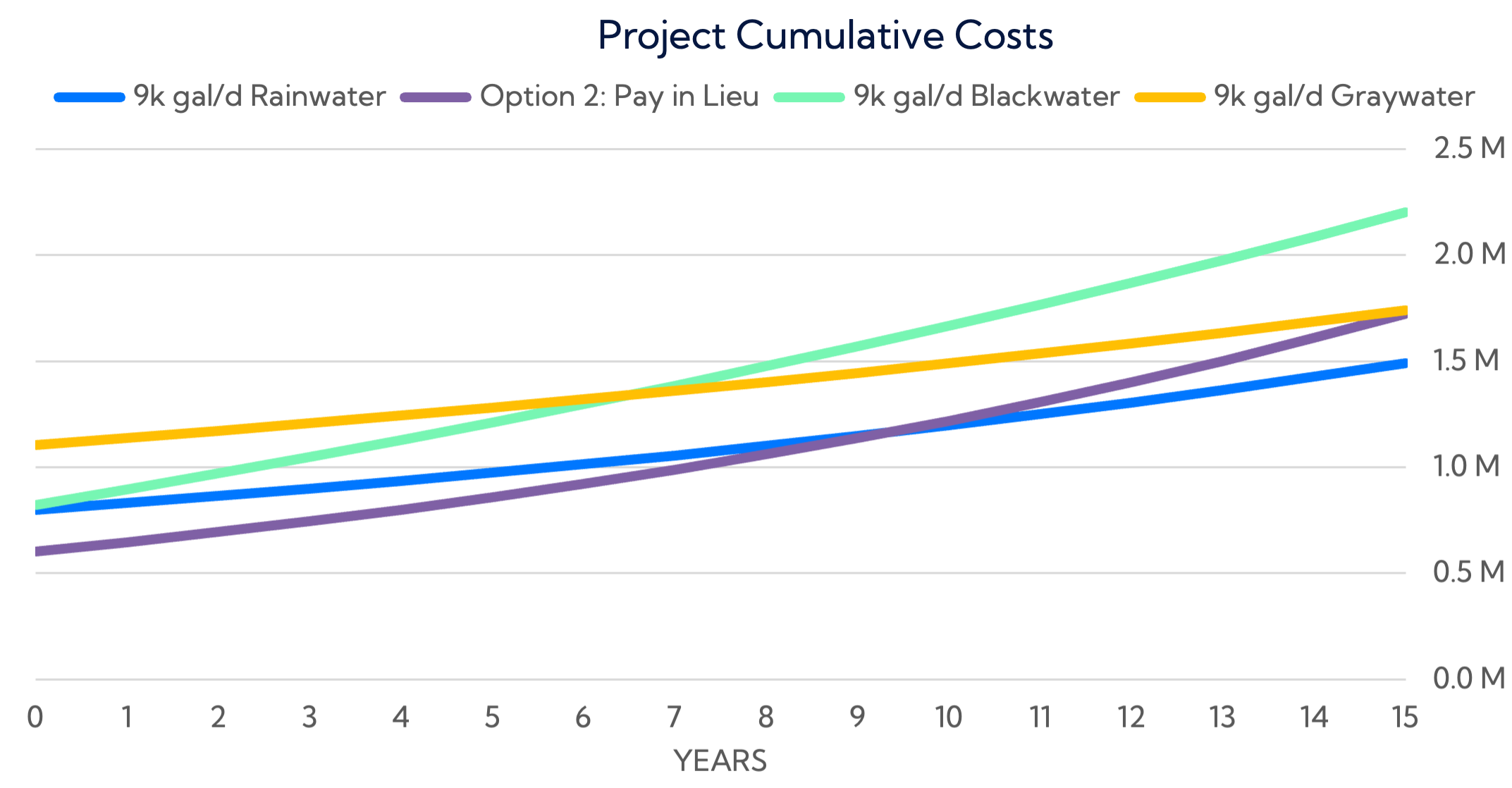
Due to the incentives, the estimated first costs for all options are similar. The question will be in the future year savings. The financial models show that the rainwater system, as compared to Option 2, will start paying itself back after year 9; the greywater system will start paying itself back around year 15; and the blackwater system will be over 20 years. From this analysis, it is most likely that the rainwater system will be the best value for an onsite reuse system, though the greywater system has a very similar curve and if first costs for greywater piping could be reduced that could also be a very financially attractive option.
Option 2, the Pay in Lieu, does not have any associated O&M; however, the additional annual costs shown are the yearly water & sewer costs to buy the water and send the wastewater back to Austin. These costs would be eliminated with the greywater and blackwater system, and reduced with the rainwater system. And remember, this project will still need to install dual plumbing even with the fee-based option.
What route should this project go? In our opinion, Option 1 (greywater or rainwater system)
Depending on the project’s goals and priorities, choosing Option 1 (installing an onsite reuse system, likely greywater or rainwater) and realizing the exponential savings after year 10 or 15 may be worth the first years’ deficit. Additionally, choosing Option 1 means the project will save over 1,700,000 gallons of municipal drinking water every year, displace the same amount from overloaded municipal sewer systems, and reap the other benefits of a decentralized, local water recycling system.
For more details on the benefits of onsite reuse systems, check out some of our previous blog posts:
- Top considerations for incorporating water reuse in architectural designs
- Is onsite water reuse right for my project?
- Calculating the ROI of water reuse in buildings
Example Project #2
Barshop & Oles Company at Brodie Oaks Development
This project is a redevelopment of the Brodie Oaks Shopping Center by developer Barshop & Oles Company. The $1 billion redevelopment will turn the space into retail, housing, and a park. The project has the following characteristics:
- 26 million sq. ft. of office space
- 140,000 sq. ft. of retail space
- 1,700 residential units
- 7 acres of outdoor green space
- 200 hotel keys
The first step is determining if the project is located within 500 feet of an existing reclaimed water municipal utility. Using Austin Water’s interactive map offering, we find that this project site is within 500 feet from a proposed extension of the city municipal recycled water main. As the code is meant to apply only for existing municipal mains, this project does not fall within the 500 ft. limit. Therefore, the same decision tree results apply to this project as in example 1.
This project differs from example 1 in that it is mixed-use and includes over 13 acres of outdoor green space, which will require irrigation from recycled water under the onsite reuse requirements. We assume the project does not include a central plant and/or cooling towers. The water balance results are as follows:
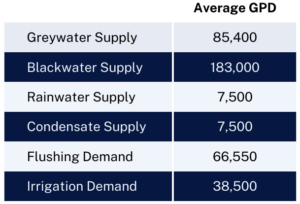
Due to the extensive parkland on the site, the project’s irrigation demand is significant. On the average day, a rainwater and condensate system would supply only 13% of the non-potable demand. On the average day, a greywater system could supply 88% of the non-potable demand; and a blackwater system would be able to meet the full non-potable demand.
With district projects, the site piping impacts are important to consider. For example, adding a site greywater collection system will have significant cost impacts, as it would be doubling the amount of site wastewater piping and pumping required. With any system chosen, site recycled water will be required. The above & beyond water savings analysis is as follows:

Since the Above & Beyond water savings are >1,000,000 gallons, the project would qualify for the $500,000 grant by installing a greywater or blackwater system. Now that we have system sizes, we can compare the preliminary costing models. Note that due to the redundancy and cost of site greywater piping, Epic would typically recommend a blackwater system for this size district project. Site piping and pumping costs are excluded from the following analysis and should be confirmed by the local site contractor.

The Year 1 costs include estimated system costs, tankage, and installation, including estimated piping costs for recycled water piping and greywater waste piping for in-building footprint. The Year 1 incentives are applicable only to greywater and blackwater projects as part of the Pilot Incentive program, whereas the annual incentives apply to all three types of systems in the form of capacity fee reductions. The annual savings are in the form of water and sewer utility savings. In addition to the incentives, including an onsite reuse system has the advantage of only having to pay connection fees for potable water, rather than both potable and recycled connections.
The high Year 1 costs are largely due to the estimated cost of recycled water piping in the buildings, which are typically estimated between $.50 and $1 per square foot. Because the rainwater and condensate system would be able to serve only a small portion of the building, we assume that the recycled water piping costs would proportionally decrease, as the project could meet minimum code by serving only the fixtures supplied by rainwater and condensate (13%).
Option 2 would be for the project to install dual plumbing to required end uses, make the required infrastructure designs to ready itself for future connection to reclaimed water, and pay a fee in lieu upfront. The fee is equal to 500 feet of linear pipe, estimated at $240,960 upfront cost for a 12” branch connection, an estimated pipe size needed to serve the full non-potable demand.

So now we have preliminary costs for all the options that would comply with the onsite reuse code. Which is the best value for the project? The graph below shows all three options’ cumulative costs over 15 years.
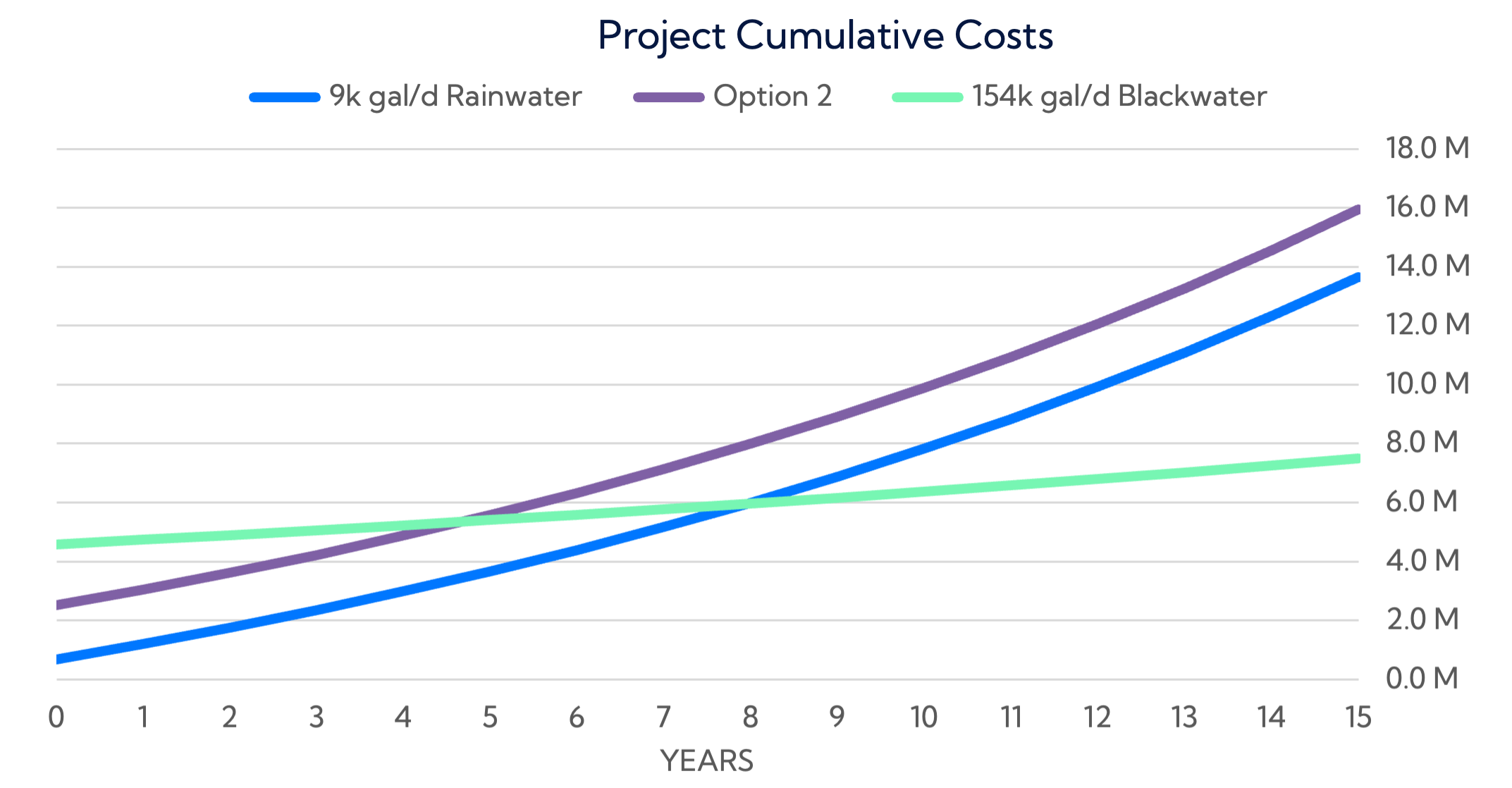
The results show that the blackwater system has the best value over seven years, though it has a higher first cost. Both the rainwater system and Option 2 include the water and sewer fees from essentially the entire non-potable demand load, but the rainwater system has a lower first cost due to the reduction in recycled water piping estimate. They follow a similar curve. The blackwater system, while it does not include site piping and pumping, is expected to maintain a better value over 15 years. Site blackwater piping can be understood as a sunk cost, as site wastewater collection piping would be required regardless of an onsite reuse system or not.
What route should this project go? In our opinion, Option 1 (Blackwater system)
If the project is very sensitive to first costs, then they might consider the rainwater and condensate system. However, the cumulative value of the blackwater system trumps the other options over year seven, and for many, that would make it the more attractive option. The optics of being an Above & Beyond water savings project under Austin Water is also attractive for many potential users and occupants, following a growing desire and push for sustainable and thoughtful buildings.
The results of the Brodie Oaks analysis point to a widely discussed attribute of onsite reuse systems: the larger the project, the greater the water and sewer savings, and typically, the more attractive the financial model.
Do you have an upcoming project in Austin?
Let’s discuss how GoPurple may affect your plans.

